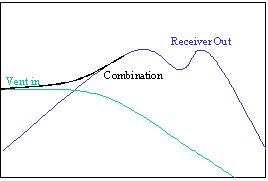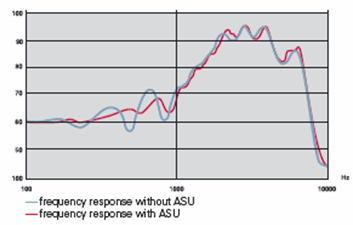Question
Please explain Adaptive Signal Unification and why it is important for Open Fitting
Answer
Open fitting is frequently the best solution for mild to moderate sloping hearing losses. Audiologists are quite familiar with the effects of sound leaking out of the ear canal through the vent.
Less obvious, are the effects of the unamplified sound entering the ear canal through the vent. Although it may seem to have little consequence, the signal entering the vent can affect the frequency response in some unexpected ways, especially in instruments with digital signal processing.
When two signals add completely in phase, the level will be doubled, which in the decibel scale means that there will be a 6 dB increase. Conversely, if the two signals are completely out of phase (180°), they will cancel each other.
Complex interactions occur when unamplified sound coming through the vent (Vent-In) combines with the amplified signal exiting the processor. Because of phase differences in the signals, there are frequency regions where the vent dominates and regions where the amplified sound dominates (Dillon, 2001). In the higher frequencies where the amplified signal is much larger, it simply overrides the effect of the vent. The problem occurs in low frequency region where the 2 signals are close in amplitude. Phase differences here cause dramatic dips and bumps in the frequency response, resulting in an audible degradation in sound quality.


Furthermore, the phase of the Vent-In signal and the amplified signal are constantly changing with frequency. When compression is applied, the frequency zone where the interactions occur also shifts as a function of input level. All of this results in notches and bumps in the frequency response that change dynamically.
With digital hearing systems, the problem becomes even worse. All digital processors delay the amplified signal slightly (between 3-15 ms for commercial hearing aids). Even a small delay acts to rapidly change the phase of the frequency response. The rapid phase changes cause the dynamic interaction of amplified sound and Vent-In sound to become even more erratic (Scheller, 2004). The resulting peaks and dips in the response can cause an audible degradation of sound quality. Research shows that any amount of delay can degrade sound quality (Dillon, et al 2003; Stone and Moore, 2003) and the lower the delay, the better the sound quality. Although faster processing helps, it does not eliminate the problem.
Adaptive Signal Unification—an effective solution
Bernafon engineers found a way to control the dynamic interaction of the Vent-In signal with the amplified signal exiting the processor. Adaptive Signal Unification (ASU) works on-line to control the electronic path of the amplified signal. By minimizing peaks and dips where the Vent-In and amplified signals combine, consistently high sound quality can be maintained for all input levels.

The blue line in Figure 3 shows the frequency response of a Symbio XT instrument without the benefit of ASU. The red line shows the response from the same instrument with ASU applied. When the vent and amplifier interaction is stabilized, the smoother frequency response ensures consistently high sound quality.
ASU is available in all Bernafon advanced instruments with ChannelFree signal processing, including Symbio XT and SwissEar instruments.
References
Dillon H. (2001). Hearing Aids. Sydney: Boomerang Press
Dillon H, Keidser G, O'Brien A and Silberstein H. (2003). Sound quality comparisons of advanced hearing aids. Hearing Journal; 56(4).
Scheller T. (2004). More than you ever wanted to know about vents and digital hearing aids. Audiology Insight;(1): 9-14. Bernafon AG, Bern.
Stone MA and Moore BC. (2003). Tolerable hearing aid delays. III. Effects on speech production and perception of across-frequency variation in delay. Ear and Hearing; 24(2):175-183.
Lorrie Scheller M.S. has been an audiologist for 25 years, working in various clinical and manufacturing settings. She is currently part of the Audiology Team at Bernafon in Switzerland and is also pursuing her AuD through the Pennsylvania College of Optometry. She can be reached at: ls@bernafon.ch
For more information on Bernafon visit the bernafon website
